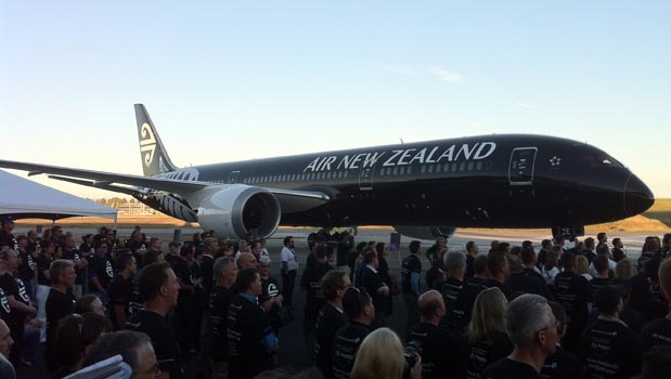
Around 6,500 Kiwi passengers have been affected by rescheduled and cancelled flights as Air New Zeland conducts checks of its Dreamliner planes.
A statement from the airline apologises for the inconvenience, explaining that the checks are necessary due to a directive issued by the European regulator, EASA.
"EASA issued a directive requiring operators of a type of Trent 1000 engine known as 'Package C' to carry out earlier than usual maintenance checks on a specific part of the engine compressor," the airline said in the statement.
"Although the requirement for engine checks is outside of our control we are doing all we can to reduce any impact, by making changes to our schedule to allow us to keep cancellations to a minimum."
Delays of this nature were anticipated following an earlier report that United States regulators would bring in tough new standards covering how far Dreamliners can fly from airports in the case of an engine shut down.
Air New Zealand's international network faces further disruption as United States regulators bring in tough new standards covering how far Dreamliners can fly from airports in the case of an engine shut down.
The Federal Aviation Administration order — seen by the Herald and about to be published online by the regulator — restricts the planes fitted with some potentially faulty Rolls-Royce engines from operating more than 140 minutes from a diversionary airport, down from 330 minutes.
Air New Zealand is already doing more frequent checks on the ''package C'' engines at the centre of the FAA directive after an alert from the European regulators.
The FAA airworthiness directive order threatens to be far more disruptive for operators of Dreamliners.
Air New Zealand this afternoon said 16 of its fleet of 27 long-haul aircraft were not Dreamliners, and would not be affected by the order and fly as normal.
One of its 11 Dreamliners is fitted with newer Rolls-Royce Trent 1000 TEN engines which are not affected by the order.
''By utilising our fleet flexibly we expect to continue to operate to all international destinations, although some routes will have aircraft and/or departure time changes. We apologise in advance to customers who may be inconvenienced during this time,'' a spokeswoman said.
The European Aviation Safety Agency last week ordered additional maintenance checks on Trent 1000 "package C" engines — of which Air New Zealand has nine — after it was found that durability issues afflicting blades were worse than first thought.
/arc-anglerfish-syd-prod-nzme.s3.amazonaws.com/public/ZTXSGHCBZRFRLDQWJTX643F2VM.jpg)
New Zealand's Civil Aviation Authority said it was working closely with the overseas regulators.
''We're confident that the action taken is appropriate to mitigate the issue and ensure the continued safety of B787 flights,'' said Mark Hughes, deputy director, air transport and airworthiness for CAA.
''We've assessed Air New Zealand's response to these matters and are satisfied that the required safety actions have been effectively implemented. We're also working closely with Air New Zealand to facilitate operational and fleet changes designed to reduce passenger disruption.''
About 350 engines on about a quarter of the global Dreamliner fleet are affected.
The FAA directive says that Boeing had reported that airflow conditions existing in the engine during operation at high thrust settings under certain temperature and altitude conditions ''excite resonant frequency'' in the intermediate pressure compressor stage 2 blades.
The resulting blade vibration can result in cumulative fatigue damage that can cause blade failure and consequent engine shutdown.
/arc-anglerfish-syd-prod-nzme.s3.amazonaws.com/public/OY6WQ4N7T5DWFCQFSJZG3YSFJI.jpg)
In the event of a single engine in-flight shutdown during the cruise phase of flight, flight crew normally increase power to maximum continuous thrust on the remaining engine, the directive says.
During a diversion following a single engine shutdown under an ETOPS (Extended-range Twin-engine Operational Performance Standards) flight, the remaining engine might operate at maximum thrust for a prolonged period, exposing the stage 2 blades to the resonant frequency condition.
''Therefore, an ETOPS diversion will put the remaining engine at an operating condition that would significantly increase the likelihood of failure of the remaining engine. In addition, if the remaining engine already had cracked IPC stage 2 blades, the likelihood of the remaining engine failing will further increase before a diversion can be safely completed,'' the FAA said.
ETOPS rules permit twin-engine aircraft to fly routes which, at some point, are more than 60 minutes flying time away from the nearest airport if they have to divert.
/arc-anglerfish-syd-prod-nzme.s3.amazonaws.com/public/LCET4S7SNBBLPFDAT7GQ5BGAH4.jpg)
The Air New Zealand spokeswoman said the nature of the disruption was ''unclear at this point".
She said the airline was continuing to work extremely closely with Rolls-Royce on this issue.
''Compensation discussions are naturally commercially sensitive.''
In an announcement to the NZX yesterday, Air New Zealand said it did not expect the Trent 1000 engine issue to materially impact its full-year earnings and previous guidance remains unchanged.
Air New Zealand shares have fallen 10c since the issue came to light at the weekend and this afternoon was trading at $3.28.
Air New Zealand experienced turbine blade problems in planes on successive days last December which helped focus global attention on the Rolls-Royce problem.
This led to accelerated repairs in Singapore for the engines and disruption to tens of thousands of passengers.
The airline was helped out by Portuguese charter operator Hi Fly which used two of its aircraft on trans-Tasman routes over summer.
Take your Radio, Podcasts and Music with you









